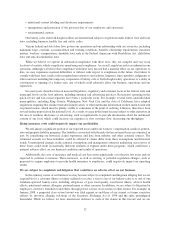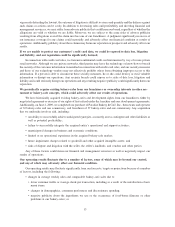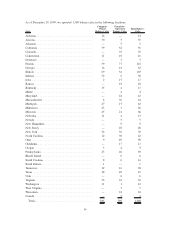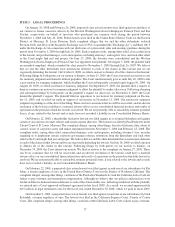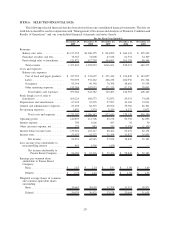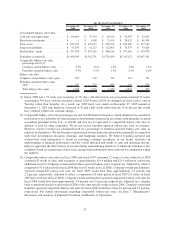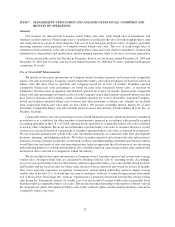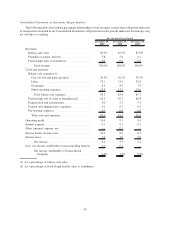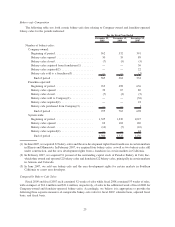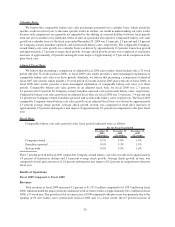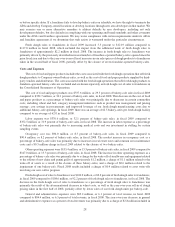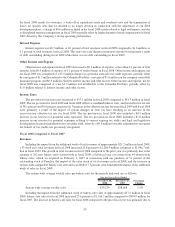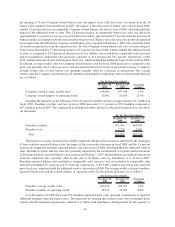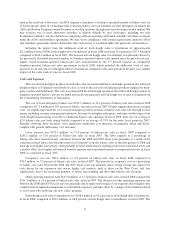Panera Bread 2009 Annual Report Download - page 28
Download and view the complete annual report
Please find page 28 of the 2009 Panera Bread annual report below. You can navigate through the pages in the report by either clicking on the pages listed below, or by using the keyword search tool below to find specific information within the annual report.ITEM 7. MANAGEMENT’S DISCUSSION AND ANALYSIS OF FINANCIAL CONDITION AND
RESULTS OF OPERATIONS
General
Our revenues are derived from Company-owned bakery-cafe sales, fresh dough sales to franchisees, and
franchise royalties and fees. Fresh dough sales to franchisees are primarily the sales of fresh dough products, tuna
and cream cheese to certain of our franchisees. The cost of food and paper products, labor, occupancy, and other
operating expenses relate primarily to Company-owned bakery-cafe sales. The cost of fresh dough sales to
franchisees relates primarily to the sale of fresh dough products, tuna and cream cheese to franchisees. General and
administrative, depreciation and amortization, and pre-opening expenses relate to all areas of revenue generation.
Our fiscal year ends on the last Tuesday in December. Each of our fiscal years ended December 29, 2009 and
December 25, 2007 had 52 weeks. Our fiscal year ended December 30, 2008 had 53 weeks, with the fourth quarter
comprising 14 weeks.
Use of Non-GAAP Measurements
We include in this report information on Company-owned, franchise-operated and system-wide comparable
bakery-cafe sales percentages. Company-owned comparable bakery-cafe sales percentages are based on sales from
bakery-cafes that have been in operation and Company-owned for at least 18 months. Franchise-operated
comparable bakery-cafe sales percentages are based on sales from franchised bakery-cafes, as reported by
franchisees, that have been in operation and franchise-operated for at least 18 months. System-wide comparable
bakery-cafe sales percentages are based on sales at both Company-owned and franchise-operated bakery-cafes that
have been in operation and Company-owned or franchise-operated for at least 18 months. Acquired Company-
owned and franchise-operated bakery-cafe locations and other restaurant or bakery-cafe concepts are excluded
from comparable bakery-cafe sales until we have held a 100 percent ownership interest therein for at least
18 months. Comparable bakery-cafe sales exclude closed locations and currently, Paradise Bakery & Café, Inc., or
Paradise, locations.
Comparable bakery-cafe sales percentages are non-GAAP financial measures, which should not be considered
in isolation or as a substitute for other measures of performance prepared in accordance with generally accepted
accounting principles in the U.S., or GAAP, and may not be equivalent to comparable bakery-cafe sales as defined
or used by other companies. We do not record franchise-operated bakery-cafe sales as revenues. However, royalty
revenues are calculated based on a percentage of franchise-operated bakery-cafe sales, as reported by franchisees.
We use franchise-operated and system-wide sales information internally in connection with store development
decisions, planning, and budgeting analyses. We believe franchise-operated and system-wide sales information is
useful in assessing consumer acceptance of our brand, facilitates an understanding of financial performance and the
overall direction and trends of sales and operating income, helps us appreciate the effectiveness of our advertising
and marketing initiatives to which our franchisees also contribute based on a percentage of their sales, and provides
information that is relevant for comparison within the industry.
We also include in this report information on Company-owned, franchise-operated and system-wide average
weekly sales. Average weekly sales are calculated by dividing total net sales by operating weeks. Accordingly,
year-over-year results reflect sales for all locations, whereas comparable bakery-cafe sales exclude closed locations
and Paradise and are based on sales for bakery-cafes that have been in operation and owned for at least 18 months.
New stores typically experience an opening “honeymoon” period during which they generate higher average
weekly sales in the first 12 to 16 weeks they are open as customers “settle-in” to normal usage patterns from initial
trial of the location. On average, the “settle-in” experienced is 5 percent to 10 percent less than the average weekly
sales during the “honeymoon” period. As a result, year-over-year results of average weekly sales are generally lower
than the results in comparable bakery-cafe sales. This results from the relationship of the number of bakery-cafes in
the “honeymoon” phase, the number of bakery-cafes in the “settle-in” phase, and the number of bakery-cafes in the
comparable bakery-cafe base.
22


